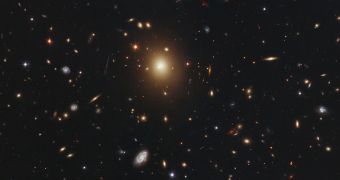The Milky Way is relatively large by galaxy standards, but there are much bigger ones in the night sky. One massive galaxy, 10 times the size of our own at one million light years across, A2261-BCG is rather peculiar.
For one, it's very big, its core is bigger than any other observed for an elliptical galaxy.
It's very bright too, with the brightness distributed across its entire volume.
Another peculiarity is that its center region, again, much bigger than normal, is rather diffuse, there are stars scattered all over the place, but there's no greater concentration at the very center as you'd expect to find in most galaxies due to the supermassive black holes that reside there.
Astronomers peeking at the galaxy three billion light years away with the Hubble Space Telescope, found that there's no central concentration of stars and came up with a couple of explanations.
Both involve two supermassive black holes orbiting one another. Put together, the two weigh in at several billion suns. One theory is that the native supermassive black hole drew in another SMBH from a smaller galaxy that A2261-BCG gobbled up.
As the two SMBHs grew closer together they shot away any star that was close enough leaving the center relatively devoid of stars. The two SMBHs finally collapsed into each other, but by that time the center was rather unpopulated.
The second theory is a variation on the first, in it the two SMBHs, one bigger than the other, were drawn together, but their attraction and their size discrepancy caused them to push away from the center of the galaxy.
The gravitational waves generated, incredibly large for such massive objects, acted as a thruster and pushed the two out of the center.
The Very Large Array radio telescope in New Mexico is currently surveying the galaxy and should pick up any radio waves emitted by whatever has the misfortune of being gobbled up by the black holes in the galaxy.
This should provide us with the location of the two SMBHs, if indeed there are two, and the possibility of proving any of the two theories. The paper describing the findings appeared in the The Astrophysical Journal.

 14 DAY TRIAL //
14 DAY TRIAL //